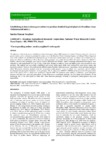Por favor, use este identificador para citar o enlazar este ítem:
http://www.alice.cnptia.embrapa.br/alice/handle/doc/1002262Registro completo de metadatos
| Campo DC | Valor | Lengua/Idioma |
|---|---|---|
| dc.contributor.author | SCAGLIUSI, S. M. M. | pt_BR |
| dc.date.accessioned | 2014-12-10T11:11:11Z | pt_BR |
| dc.date.available | 2014-12-10T11:11:11Z | pt_BR |
| dc.date.created | 2014-12-10 | pt_BR |
| dc.date.issued | 2014 | pt_BR |
| dc.identifier.citation | Australian Journal of Crop Science, v. 8, n. 6, p. 887-894, 2014. | pt_BR |
| dc.identifier.issn | 1835-2707 | pt_BR |
| dc.identifier.uri | http://www.alice.cnptia.embrapa.br/alice/handle/doc/1002262 | pt_BR |
| dc.description | The objective of this study was to establish an isolated microspore culture (IMC) protocol in wheat (Triticum aestivum L.) for use in genetic studies and to evaluate its potential for routine use in the Brazilian Wheat Breeding Program at Embrapa Wheat. Important steps of the method were identified and plant physiology of microspore mother plants and ovary co-culture were considered as key factors for effective establishment. Three Brazilian wheat genotypes were tested (Toropi, BRS 194 and F1 wheat cross 020037 × 020062), and two other genotypes were used as controls (Bobwhite and Fielder). Spikes containing uninucleated microspores were subjected to cold pretreatment (4°C) for 21 days in the dark. Number of embryos, green and albino plants were recorded for each genotype. The method was successfully established, and several fertile green plants were produced by using tissue culture and responsive controls. However, the results greatly differed among Brazilian wheat genotypes, suggesting a strong genotype-dependent effect. Microspore induction medium alone did not promote embryogenesis; ovary co-culture was a necessary step for embryo development and green plant formation, for all genotypes. The F1 wheat cross (020037 × 020062) produced a total of 85 green plants (out of 108 spikes), 64% of which were spontaneous diploids. BRS 194 produced many embryos, exhibiting a good androgenic response, but only a few grew into green plants. Toropi behaved as a recalcitrant genotype, and zero plants were produced. To our knowledge, this is the first report on wheat IMC from Brazilian genotypes resulting in androgenic embryogenesis and plant regeneration. | pt_BR |
| dc.language.iso | eng | eng |
| dc.rights | openAccess | eng |
| dc.subject | Microspore culture | pt_BR |
| dc.subject | Wheat breeding | pt_BR |
| dc.subject | Brasil | pt_BR |
| dc.subject | Duplo haplóide | pt_BR |
| dc.title | Establishing isolated microspore culture to produce doubled haploid plants in Brazilian wheat (Triticum aestivum L.). | pt_BR |
| dc.type | Artigo de periódico | pt_BR |
| dc.date.updated | 2015-02-01T11:11:11Z | pt_BR |
| dc.subject.thesagro | Melhoramento Genético Vegetal | pt_BR |
| dc.subject.thesagro | Trigo | pt_BR |
| dc.subject.nalthesaurus | androgenesis | pt_BR |
| riaa.ainfo.id | 1002262 | pt_BR |
| riaa.ainfo.lastupdate | 2015-02-01 | pt_BR |
| dc.contributor.institution | SANDRA MARIA MANSUR SCAGLIUSI, CNPT. | pt_BR |
| Aparece en las colecciones: | Artigo em periódico indexado (CNPT)  | |
Ficheros en este ítem:
| Fichero | Descripción | Tamaño | Formato | |
|---|---|---|---|---|
| 2014AustralianJournalofCropSciencev8n6p887.pdf | 513,01 kB | Adobe PDF |  Visualizar/Abrir |









